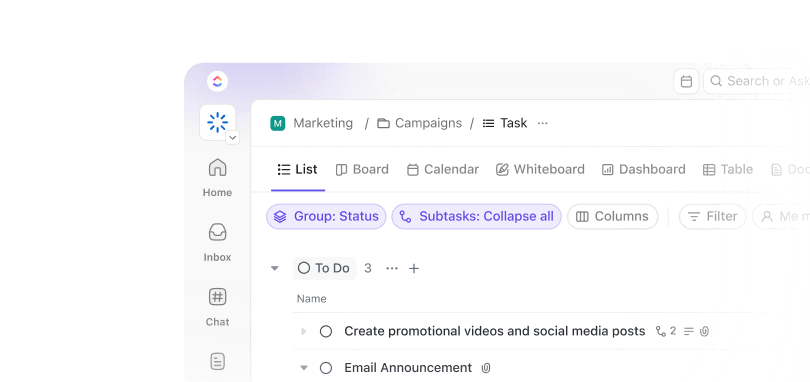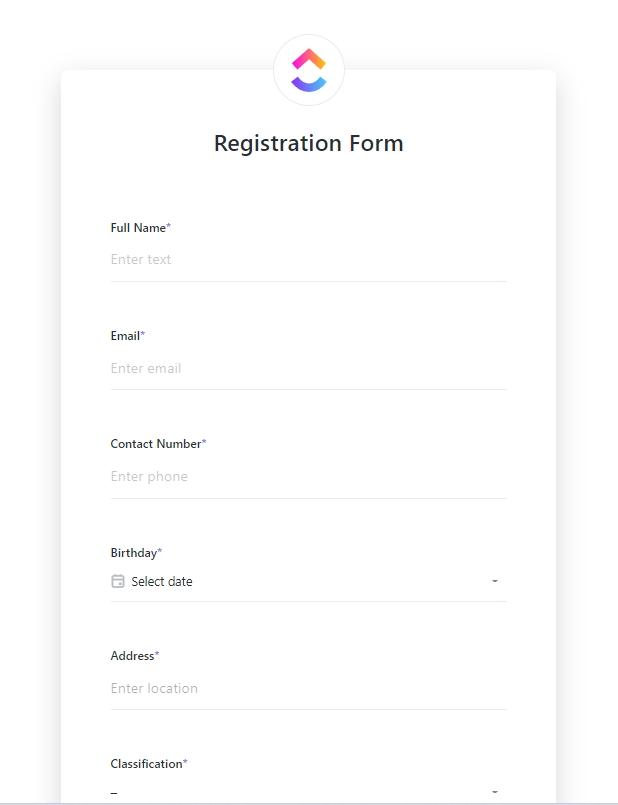Are you having trouble choosing between Jotform and Typeform?
Both have a solid reputation for helping teams create beautiful, practical forms, but their approaches differ significantly.
While Jotform offers sophisticated features, templates, and advanced form logic, Typeform prioritizes elegant, user-friendly design and a more conversational experience.
At first glance, it is a toss-up. However, when juggling projects, creating feedback form templates, or managing client interactions, the form tool you use should be convenient and work for you.
In this article, we’ll compare the real differences between Typeform and Jotform. And if you’re looking for Typeform and Jotform, we’ve got what you need. ✨
Jotform vs. Typeform at a Glance
| Feature / Tool | Jotform | Typeform | ClickUp (Bonus) |
| Form Design & UI | Traditional forms, highly customizable, multi-page, CSS support | Conversational, one question at a time, modern & engaging | Drag-and-drop builder, customizable, supports visuals & instructions, integrated with workflows |
| Conditional Logic | Advanced (show/hide fields, custom notifications, redirects) | Logic Jumps (dynamic branching, smart validation) | Integrated conditional logic for forms and workflows |
| Payment Integrations | 40+ gateways (Stripe, PayPal, Square, etc.), recurring payments, no extra fees | Stripe, Square (limited options) | Native ClickUp payments not supported, but can connect via integrations |
| Analytics & Reporting | Built-in analytics, visual reports, export to Excel/Sheets | Basic analytics, integrates with Google Analytics & Facebook Pixel | Custom dashboards, survey reports, AI-powered insights |
| Integrations | Google Sheets, Dropbox, Slack, Trello, Airtable, Salesforce, Mailchimp, etc. | Google Sheets, Slack, HubSpot, Mailchimp, Zapier, etc. | 1,000+ integrations, automations, connects forms to tasks, docs, chat, and more |
| Mobile Support | Mobile-optimized forms, offline data collection via app | Mobile-friendly forms | Mobile app, forms accessible and actionable on mobile |
| Ease of Use | Feature-rich, slight learning curve for advanced features | Extremely easy, minimal learning curve | Intuitive for forms, plus project management, docs, and automation in one place |
| Automation | Automated workflows, email alerts, CRM handoffs | Limited automation | Powerful automations, triggers, and AI agents across forms and all work |
| Pricing (Monthly) | Free, Bronze $39, Silver $49, Gold $129, Enterprise (custom) | Basic $29, Plus $59, Business $99, Growth Essential $119, Pro $349, Custom | Free forever; paid plans available |
| Best For | Teams needing advanced forms, payments, and deep customization | User-friendly, engaging surveys, feedback, and lead capture | Teams wanting forms + project management, automation, docs, dashboards, and AI—all in one platform |
What Is Jotform?
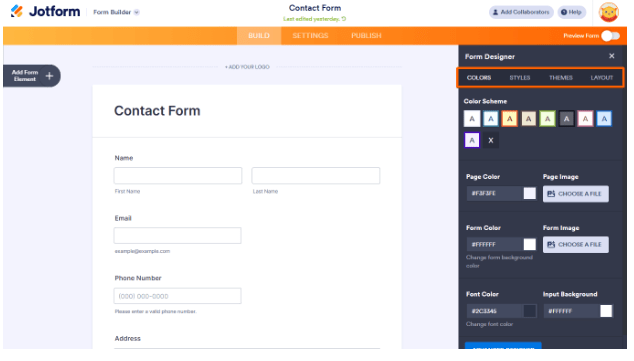
Jotform is a powerful and flexible online form builder designed to simplify creating, managing, and analyzing forms for various use cases. This online form builder allows users to construct and manage forms easily using a drag-and-drop interface.
However, its capabilities go far beyond the basic form creation process. Over the years, Jotform has evolved into a multifunctional platform with advanced form features like a mobile form app, a PDF form editor, e-signature support, and powerful integrations.
This makes it ideal for teams and organizations looking to automate data collection and streamline administrative workflows.
Whether collecting customer feedback, processing payments, onboarding new employees, or registering event attendees, Jotform provides the tools to create functional and visually appealing forms easily.
➡️ Read More: Best Jotform Alternatives to Try
Jotform features
Jotform provides comprehensive tools for improving form generation and data collection. These simplify the process of creating, sharing, and managing forms for software teams with different levels of technical knowledge. Here’s a breakdown of Jotform’s features:
1. Drag-and-drop form builder
Jotform’s simple drag-and-drop form builder interface enables users to design bespoke forms without requiring technical skills.
Add and customize form fields, widgets, and connectors to meet your needs. There are also options to bring intext boxes, dropdowns, checkboxes, file upload fields, and widgets onto the canvas and rearrange them as needed.
Start from scratch or choose from thousands of ready-to-use templates. Advanced design controls make matching forms to your brand identity easy by customizing colors, fonts, and layout settings—no design or technical background required.
2. Conditional logic
Conditional logic allows forms to dynamically show or hide fields based on user replies, resulting in a more personalized experience and expediting the data collection process.
With Jotform’s conditional logic capabilities, you tailor the user experience based on input responses. This allows you to show or hide form fields, send custom notifications, or redirect users after submission, depending on how they answer specific questions.
Such dynamic interaction streamlines the form-filling process and ensures that respondents are only asked relevant questions, reducing drop-offs and improving data accuracy.
3. Payment integrations
Jotform supports over 30 secure payment gateway integrations, including Stripe, PayPal, and Square.
Alongside built-in payment collection, you can easily get customer feedback and create order forms, event registration pages, donation forms, or subscription-based services without incurring additional transaction fees from Jotform itself.
The tool also allows you to configure recurring payments, set up invoices, or add tax and shipping options within minutes.
4. Mobile responsiveness
Jotform forms are mobile-optimized, ensuring an intuitive interface for consumers on smartphones or tablets.
In addition, the Jotform Mobile Forms app allows users to collect data even when offline. Once an internet connection is restored, all responses are automatically synced to the cloud.
This is especially useful for field teams, researchers, or event staff who operate in low-connectivity environments.
5. Integration with third-party applications
Jotform integrates with various third-party applications, including Google Sheets, Dropbox, Slack, Trello, Airtable, Mailchimp, and Salesforce. These integrations allow automatic response syncing, real-time notifications, and smoother handoffs between teams or tools.
Also, automated workflows can be set up, such as forwarding new submissions to a CRM or triggering email alerts, without needing additional automation platforms.
6. Advanced form analytics
Jotform includes built-in analytics tools that help users track form performance, submission rates, and user behavior.
With visual reports and response trends, identify drop-off points, optimize questions for clarity, and make informed decisions about form structure and content. These insights are invaluable for improving engagement and ensuring data quality.
Jotform pricing
- Starter: Free
- Bronze: $39/month
- Silver: $49/month
- Gold: $129/month
- Enterprise: Custom pricing
🧠 Fun Fact: The first online form was created in 1993 by researchers at the National Center for Supercomputing Applications (NCSA). It included a single text box, which allowed users to search for documents on the NCSA website.
What Is Typeform?
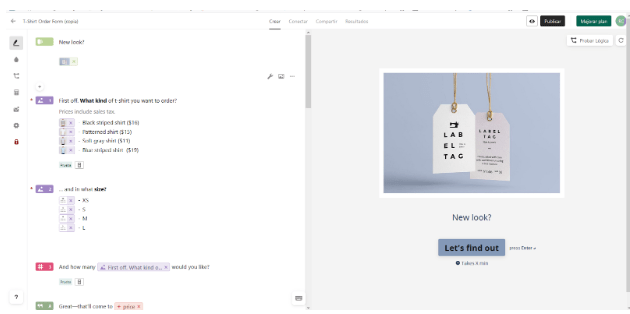
Typeform is an innovative online platform that transforms traditional form-building into a dynamic, interactive experience.
Known for its sleek, conversational forms, Typeform allows users to create engaging surveys, quizzes, contact forms, and polls—without writing a single line of code.
Whether gathering customer insights and user feedback, conducting employee feedback, or running a lead generation campaign, Typeform helps create forms that feel more like human conversations than static questionnaires.
Moreover, Typeform offers a compelling blend of design flexibility, conditional logic, and seamless integrations for businesses seeking the right form builder to elevate their data collection strategy.
Its unique approach to user interaction sets Typeform apart from traditional form builders. Instead of presenting all questions at once, Typeform displays one question at a time, mimicking the flow of a natural dialogue.
This conversational interface makes forms more engaging and boosts response rates by reducing the cognitive load on users.
➡️ Read More: Top Typeform Alternatives and Competitors
Typeform features
Typeform provides capabilities for creating dynamic and user-friendly forms that react to employee feedback. These features seek to give users a more personalized and engaging experience.
1. Conversational interface
Typeform’s design displays questions simultaneously, simulating a conversational discussion. This method improves user engagement and results in greater completion rates.
The core of Typeform’s appeal is its conversational layout and user-friendly interface. By presenting questions individually, Typeform’s form builder creates a focused and personal experience for respondents. This approach is ideal for contact forms, employee engagement surveys, and feedback forms, where tone and simplicity matter.
2. Logic Jumps
Typeform’s Logic Jumps feature introduces smart form validation and dynamic branching, allowing the form to adapt based on a respondent’s previous answers. This helps users create relevant, personalized experiences and streamline data collection.
So, start building a quiz or onboarding form with Logic Jumps that ensure only pertinent questions are shown, saving time for both the user and the respondent.
3. Multimedia integration
Elevate your forms with images, videos, and GIFs to create visually rich and interactive experiences. This is particularly effective for brand storytelling, product demos, employee surveys, or onboarding quizzes.
Multimedia support transforms static surveys into immersive forms that keep users engaged, perfect for capturing high-quality form data.
4. Customizable templates and branding
Maintaining brand consistency is essential, and Typeform offers customizable template options to support that.
From choosing brand-specific fonts and colors to uploading logos and adjusting layout styles, you can tailor each form to align with your visual identity. This ensures that even your traditional form content looks polished and professional, like contact forms or registration pages.
5. Integration with third-party applications
Typeform integrates with popular third-party platforms such as Google Sheets, Slack, HubSpot, and Mailchimp, making it easier to automate your workflows and manage collected data efficiently.
Plus, seamlessly sync responses for analytics, trigger emails, or push leads into your CRM. These integrations support smarter business decisions and real-time action on collected data.
6. Unlimited forms and responses
For users on paid plans, Typeform offers the flexibility to create unlimited forms with no cap on the number of responses, making it suitable for scaling businesses and growing teams.
This feature is especially useful when running multiple concurrent campaigns or managing company-wide surveys without restrictions.
Typeform pricing
- Basic: $29/month
- Plus: $59/month
- Business: $99/month
- Enterprise: Custom pricing
- Growth Essential: $119/month
- Growth Pro: $349/month
- Growth Custom: Custom pricing
Jotform vs. Typeform: Features Compared
When choosing the right form builder, the decision often comes down to the finer details and advanced features—form design, integrations, customization, data analysis, and pricing.
Both Typeform and Jotform offer compelling solutions, but they cater to different workflows and user preferences.
Below is a detailed comparison of Typeform vs. Jotform across six key areas to help you determine which platform is better suited for your needs.
Feature 1: Form design and user interface
Typeform is celebrated for its unique conversational form style that mimics a one-on-one dialogue. This design approach presents one question at a time, guiding users through a seamless and engaging experience.
The minimalist layout helps reduce cognitive overload, which often results in improved completion rates and more thoughtful responses. It’s ideal for feedback forms, employee engagement surveys, and quizzes that require user interaction and focus.
Jotform, by contrast, sticks to a more traditional form layout but offers powerful design flexibility. Access customizable templates for various industries, from healthcare to education and e-commerce.
Plus, rearrange sections, use multi-page formats, or apply conditional fields. Jotform also supports embedded CSS and layout changes, giving advanced users more freedom to create complex form designs.
Winner: Typeform for its engagement-driven interfaces.
Feature 2: Integrations and payment processing
Both tools offer broad integration options with popular apps like Google Sheets, Slack, Mailchimp, and HubSpot, helping you automate workflows and sync collected data in real-time.
However, there’s a significant difference when it comes to payment processing.
Jotform leads with over 40 payment gateway integrations, including PayPal, Stripe, Square, Authorize.net, and even region-specific platforms. You can configure recurring payments, tax settings, product listings, and more—all without incurring additional transaction fees from Jotform.
While effective for lead capture and surveys, Typeform supports a narrower range of payment gateways—primarily Stripe and Square. This limitation makes it less ideal for e-commerce or donation-based forms that require varied transaction methods.
Winner: Jotform because of its superior payment processing capabilities and flexibility.
Feature 3: Conditional logic and customization
Dynamic forms rely heavily on conditional logic to personalize the respondent’s journey.
Jotform and Typeform support this feature, allowing users to tailor the next question based on prior answers. This makes for smarter surveys, streamlined workflows, and more relevant data collection.
However, Jotform pushes the envelope with deeper customization with custom widgets, HTML/CSS coding, and adding calculations or auto-responses. This gives Jotform the upper hand for advanced use cases, such as registration forms that compute fees based on selections or intake forms that autofill specific values.
Typeform takes a more simplified approach, prioritizing usability over complexity. While this enhances the user experience for form creators, it restricts deeper technical customizations that some power users may need.
Winner: Jotform because of its more flexible and technically exhaustive customization features.
Feature 4: Analytics and reporting
Jotform provides in-depth form analytics, offering users access to submission trends, user locations, conversion rates, and drop-off points.
Reports can be visualized within Jotform’s dashboard or exported to Excel, Google Sheets, or third-party tools via integration. Visual charts can even be generated for presentations or internal reviews.
Typeform includes basic analytics such as response count, completion rate, and average time per response. It also integrates with Google Analytics and Facebook Pixel for deeper tracking, but lacks native reporting tools as comprehensive as Jotform’s. Users often need to depend on external platforms to unlock more detailed insights.
Winner: Draw—Jotform excels at native reporting, while Typeform connects well with external analytics tools.
Feature 5: Pricing and scalability
Cost is crucial, especially when scaling usage across teams or departments.
Typeform’s pricing is structured around monthly responses, starting at a higher baseline than many competitors. While it provides elegant forms, the value-per-feature ratio may not justify the cost for small teams or those needing unlimited form submissions.
Jotform, on the other hand, offers more generous free and paid plans, including support for monthly submissions, storage, and form fields.
Its free plan is especially competitive, giving users access to core features with fewer restrictions. For organizations needing unlimited forms and larger response quotas, Jotform delivers more value at scale.
Winner: Jotform is ideal for growing teams due to its affordable, scalable plans.
Feature 6: User experience and learning curve
Typeform shines when it comes to ease of use. Its minimalist editor, real-time previews, and well-organized interface make it extremely approachable—even for users unfamiliar with form-building tools. The step-by-step structure and pre-built templates reduce setup time and eliminate confusion.
While feature-rich, Jotform can feel slightly more complex due to its advanced settings, widgets, and customization tools. Beginners may need more time to understand the interface and functionality, particularly when diving into conditional logic or integrations.
Winner: Typeform for its best-in-class simplicity, quick learning, and frictionless user experience.
Jotform vs. Typeform on Reddit
To get a better idea of how Jotform and Typeform differ in real-world usage, we looked at Jotform vs. Typeform on Reddit, where people shared their experiences with each platform.
Many Reddit users like Jotform’s broad integrations and customization options:
However, some users have noted concerns regarding Jotform’s performance and pricing:
On the other hand, Typeform is often praised for its engaging user experience:
Some users have expressed concerns about Typeform’s pricing structure:
Meet ClickUp: The Best Alternative to Jotform and Typeform
ClickUp, the everything app for work, is a comprehensive alternative that provides sophisticated form-building capabilities and project management, automation, and analytics tools.
This integration ensures that data collection is immediately linked to your workflows, which increases efficiency and productivity.
ClickUp’s One Up #1: Integrated form builder

ClickUp Forms enables you to design custom forms directly linked to your workflows. Each form submission automatically produces tasks with particular parameters such as assignees, due dates, and priority levels. Such functionality reduces laborious data entry and keeps everything organized in one location.
This speeds up the transition from data collection to actionable activities. The straightforward drag-and-drop interface accommodates a variety of field types, including text boxes, drop-downs, and checkboxes, to meet a wide range of data-collection requirements.
What distinguishes ClickUp Forms is its comprehensive incorporation of all aspects of your workflow. Use submissions to create tasks in the appropriate list, populate Custom Fields, and even assign tasks to specific team members without leaving the platform. Furthermore, integrated conditional logic can support complex workflows.
In short, ClickUp Forms helps you:
- Save time with an intuitive Form builder: Quickly create and customize forms without any technical skills, so you can focus on gathering the information you need
- Unlock insights with AI-powered analysis: Instantly turn responses into actionable data, helping you make smarter decisions faster
- Guide respondents with informational blocks and question descriptions: Add clear instructions and helpful context directly within your forms to improve response quality
- Enhance clarity with in-line visuals and instructions: Use images and descriptive text alongside questions to make forms more engaging and easier to complete
- Stay organized with the centralized Forms Hub: Access, manage, and track all your forms and responses in one convenient location
- Strengthen your brand with customization options: Personalize cover images, backgrounds, and button colors to ensure every form reflects your unique style
- Streamline workflows with seamless ClickUp integration: Automatically turn form submissions into tasks, keeping your team’s work connected and actionable
- Centralize feedback for better collaboration: Collect all feedback in one place, making it easy to review and act on input from your team or clients
ClickUp’s One Up #2: Powerful automations
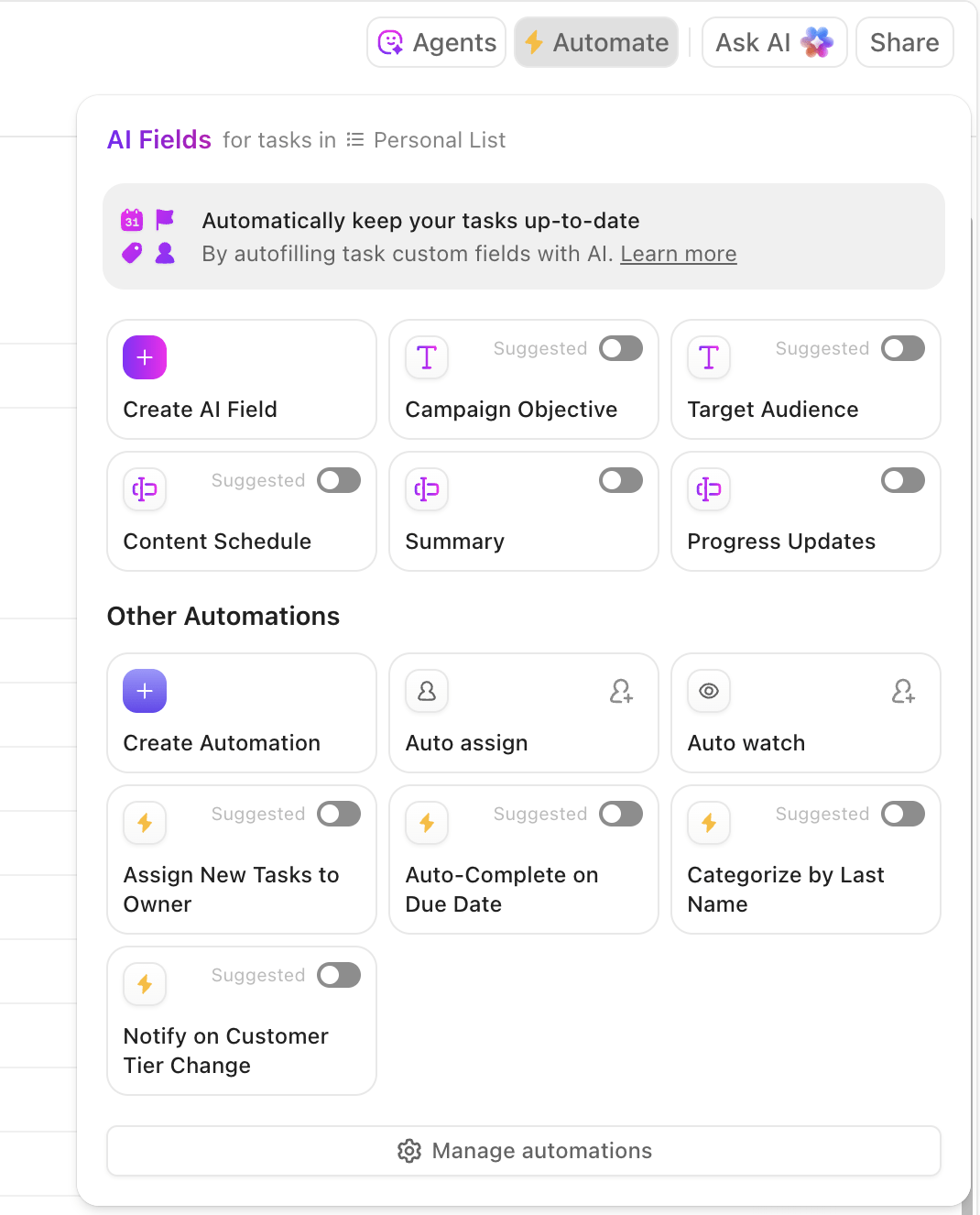
With ClickUp Automations, repetitive tasks are eliminated.
Unlike other form tools, ClickUp’s automations are part of a larger workflow ecosystem. You can initiate actions based on form submissions, time, task activity, dependencies, and status changes throughout the workspace. This feature enables you to create sophisticated end-to-end processes for running marketing campaigns, onboarding clients, and managing IT requests.
Learn more about agentic, automated workflows in ClickUp with this short video:
ClickUp’s One Up #3: Comprehensive dashboards

ClickUp Dashboards give you a high-level perspective of your projects and team performance. Create custom reports with numerous widgets for measuring parameters like time, sprint progress, and sales overviews.
Dashboards bring visibility that Typeform and Jotform alternatives don’t offer. It allows you to track performance, create survey reports, and present outcomes to stakeholders in one place. This unified depiction helps teams make more informed decisions and stay on track with their goals.
💡 Pro Tip: Connect relevant tasks and lists in ClickUp Dashboards to gain a clear, high-level overview of your financial performance, empowering faster, data-driven decisions.
ClickUp’s One Up #4: ClickUp Brain
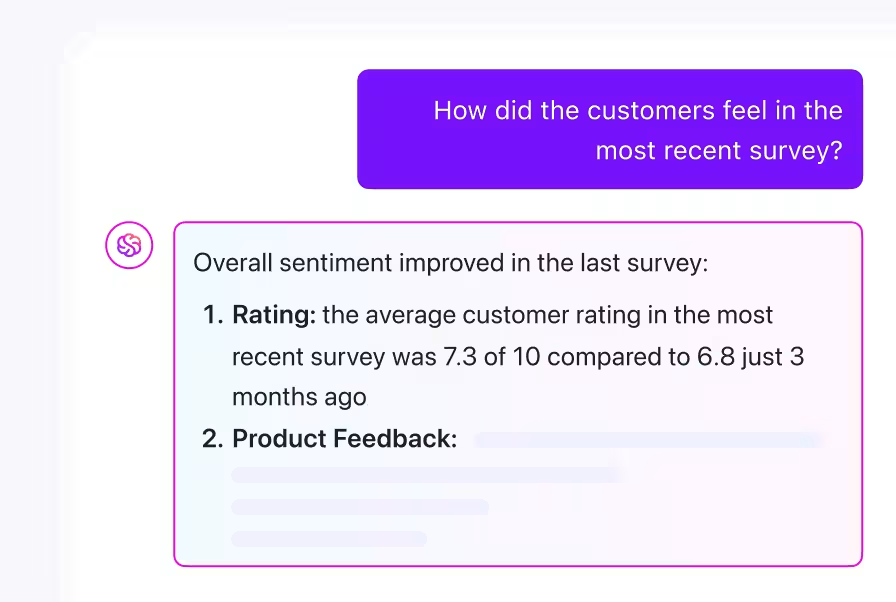
ClickUp Brain is the platform’s built-in AI helper, meant to increase overall productivity. ClickUp Brain helps your team work smarter, not harder, by summarizing tasks, producing project updates, and answering queries regarding workspace content.
Do you need to create an email, summarize a meeting, or generate customer service survey questions? ClickUp Brain manages it all without changing tools or context.
If you want to take AI capabilities a step further, Brain MAX, the AI desktop companion from ClickUp, offers talk-to-text features, powerful enterprise search, access to multiple LLMs, instant image generation, and more from a single desktop app!
You can use ClickUp Brain as an AI form builder and generate a customer feedback structure. Here’s one we made:
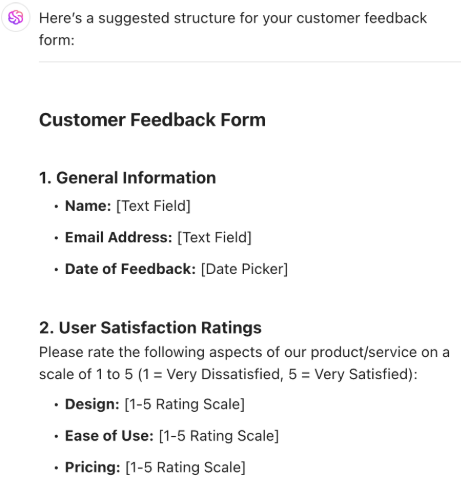
🎁 Bonus: ClickUp Form Template
The ClickUp Form Template simplifies the process of developing and managing forms, making it accessible to teams of any size. This template makes data collection more efficient and keeps submissions structured for quick inspection and action.
Why you’ll like it:
- Create unique forms with its intuitive design, which includes a range of field types, such as text boxes, dropdowns, and checkboxes
- Optimize the workflow, allowing you to concentrate on analyzing responses and making sound decisions
- Collect and organize submissions from the users for better insights
Resolve the Jotform vs. Typeform Debate with ClickUp
When picking between Jotform and Typeform, both tools have unique characteristics, whether it’s Jotform’s broad integrations and form logic or Typeform’s slick, user-friendly design.
However, if you’re searching for a platform that collects information and converts it into action, look no further. ClickUp outperforms standard AI form builders with its fully integrated forms, automations, and dashboards.
It integrates your data into your workflows, automates procedures to empower your team, and provides clear progress visibility—all in one location. So, instead of managing several tools, why not consolidate everything under one platform?
Sign up for free today and experience what form building looks like when it’s built for productivity.

